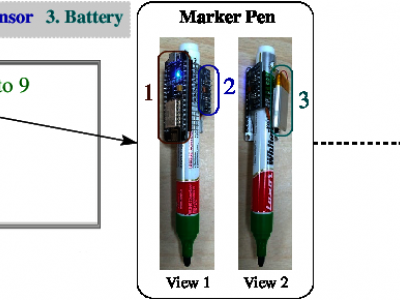Machine Learning

This MATLAB dataset (.mat) contains the collected real measurement data from a total of 470 access points (APs) deployed in the Linnanmaa campus of the University of Oulu, Finland. The measurements include IDs, dates of data collection, number of users, received traffic data, transmitted traffic data and location names of each AP. Each observation of traffic data and number of users provide the data value at every 10-minute interval between December 18, 2018 and February 12, 2019. Please cite this as: S. P. Sone & Janne Lehtomäki & Zaheer Khan.
- Categories:
 2242 Views
2242 Views
E-nose can be used for food authentication and adulteration assessment. Recently, halal authentication has gained attention because of cases of pork adulteration in beef. In this study, The electronic nose was built using nine MQ series gas sensors from Zhengzhou Winsen Electronics Technology Co., Ltd for detection pork adulteration in beef. The list of gas sensors are MQ2, MQ4, MQ6, MQ9, MQ135, MQ136, MQ137, and MQ138. These gas sensors were assembled with an Arduino microcontroller.
- Categories:
 1253 Views
1253 ViewsThis data set includes Covid-19 related Tweet messages written in Turkish that contain at least one of four keywords (Covid, Kovid, Corona, Korona). These keywords are used to express Covid-19 virus in Turkey. Tweets collection was started from 11th March 2020, the first Covid-19 case seen in Turkey.
Currently dataset contain 4,8 million tweets with 6 different attribute of each tweets that were sent from 9 March 2020 until 6 May 2020.
The data file contains comma separated values (CSV). It contains the following information (6 Column) for each tweet in the data file:
- Categories:
 5669 Views
5669 ViewsWe collected experimental field data with a prototype open-ended waveguide sensor (WR975) operating between 600 MHz - 1300 MHz. With our prototype sensor we collected reflection coefficient measurements at a total of 50 unique 1-ft^2 sites across two separate established cranberry beds in central Wisconsin. The sensor was placed directly on top of cranberry-crop bed canopies, and we obtained 12 independent reflection coefficient measurements (each defined as one S11 sweep across frequency) at each 1-ft^2 site by randomly rotating and/or translating the sensor aperture above each site. After
- Categories:
 293 Views
293 ViewsThe PRIME-FP20 dataset is established for development and evaluation of retinal vessel segmentation algorithms in ultra-widefield (UWF) fundus photography (FP). PRIME-FP20 provides 15 high-resolution UWF FP images acquired using the Optos 200Tx camera (Optos plc, Dunfermline, United Kingdom), the corresponding labeled binary vessel maps, and the corresponding binary masks for the valid data region for the images. For each UWF FP image, a concurrently captured UWF fluorescein angiography (FA) is also included.
- Categories:
 3507 Views
3507 ViewsThis dataset consists of sensory data of digits, i.e., from 0 to 9. The dataset is collected from 20 volunteers by using a 9−axis Inertial Measurement Unit (IMU) equipped marker pen. The objective of this dataset is to design classification algorithms for recognizing a handwritten digit in real-time.
- Categories:
 2219 Views
2219 ViewsAcademic spaces are an environment that promotes student performance not only because of the quality of its equipment, but also because of its ambient comfort conditions, which can be controlled by means of actuators that receive data from sensors. Something similar can be said about other environments, such as home, business, or industry environment. However, sensor devices can cause faults or inaccurate readings in a timely manner, affecting control mechanisms. The mutual relationship between ambient variables can be a source of knowledge to predict a variable in case a sensor fails.
- Categories:
 488 Views
488 ViewsThis dataset (GeoCOV19Tweets) contains IDs and sentiment scores of geo-tagged tweets related to the COVID-19 pandemic. The real-time Twitter feed is monitored for coronavirus-related tweets using 90+ different keywords and hashtags that are commonly used while referencing the pandemic. Complying with Twitter's content redistribution policy, only the tweet IDs are shared. The tweet IDs in this dataset belong to the tweets created providing an exact location.
- Categories:
 40316 Views
40316 ViewsWith the increasing popularity of the Internet of Things (IoT), security issues in the IoT
network have become the focus of research. Since the number of IoT devices connected to the network
has increased, the conventional network framework faces several problems in terms of network latency
and resource overload. Fog computing is intended to construct a new network framework. However, fog
computing has also caused new security challenges, such as authentication, authorization, and secure
- Categories:
 2049 Views
2049 Views





